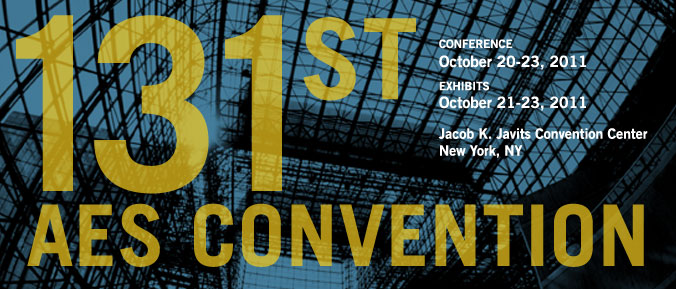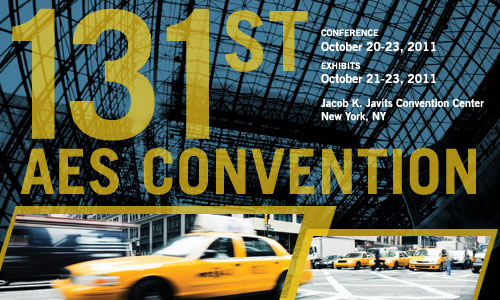
AES New York 2011
Paper Session P2
P2 - Recording and Sound Production
Thursday, October 20, 9:00 am — 11:00 am (Room: 1E07)
Chair:
Justin Paterson, University of West London - London, UK
P2-1 Computer Assisted Microphone Array Design (CAMAD)—Michael Williams, Freelance Sound Recording Engineer and Lecturer - Sounds of Scotland, Le Perreux sur Marne, France
The basic aim of Microphone Array Design is to create microphone array recording systems with smooth seamless or “Critically Linked” segment coverage of the surround sound field. Each configuration must take into account the interaction of the many design parameters, with the specific coverage of each segment that is required. The difficulty in the manipulation of these many parameters is one of the major obstacles in developing a wide range of microphone arrays that meet the needs of each particular sound recording environment. This paper will outline the various parameters that need to be taken into consideration and explain the basic approach to developing MATLAB-based software that gives a clear and unambiguous display of all the salient characteristics needed to achieve a stable and reliable microphone array, no matter the number of channels involved, or the type of directivity pattern chosen for each microphone.
Convention Paper 8461 (Purchase now)
P2-2 In Situ Measurements of the Concert Grand Piano—Brett Leonard, McGill University - Montreal, Quebec, Canada, Centre for Interdisciplinary Research in Music, Media and Technology, Montreal, Quebec, Canada; Grzegorz Sikora, McGill University - Montreal, Quebec, Canada; Martha de Francisco, McGill University - Montreal, Quebec, Canada, Centre for Interdisciplinary Research in Music, Media and Technology, Montreal, Quebec, Canada
An in situ approach to the acoustical study of the grand piano is presented in which the instrument is coupled with a typical, reflective recording space. By using accurate, tightly controlled automated playback of expertly performed material, a small number of high-quality transducers are employed to capture more than 1300 spatially distributed data points in the process known as acoustic space sampling (AcSS). The AcSS measurement task is performed on two pianos in two unique recording environments. The data is analyzed using accepted acoustic metrics and psychoacoustic predictors. It is shown that certain spatial areas containing salient physical and psychoacoustic measures are highly correlated recording engineer preference.
Convention Paper 8462 (Purchase now)
P2-3 Beyond Surround Sound—Creation, Coding and Reproduction of 3-D Audio Soundtracks—Jean-Marc Jot, Zoran Fejzo, DTS, Inc.
We propose a flexible and practical end-to-end solution for creating, encoding, transmitting, decoding, and reproducing spatial audio soundtracks. The soundtrack encoding format is compatible with legacy surround-sound decoders, while enabling the representation of a three-dimensional audio scene, irrespective of the listener’s playback system configuration. It allows for encoding one or more selected audio objects that can be rendered with optimal fidelity and interactively in any target spatial audio format (existing or future). The transmission or storage data rate and the decoder complexity are scalable at delivery time. A 3-D audio soundtrack may thus be produced once and transmitted or broadcast and reproduced as faithfully as possible on the broadest range of target devices.
Convention Paper 8463 (Purchase now)
P2-4 The Effects of Multiple Arrivals on the Intelligibility of Reinforced Speech—Timothy J. Ryan, Richard King, McGill University - Montreal, Quebec, Canada; Jonas Braasch, Rensselaer Polytechnic University - Troy, NY, USA; William L. Martens, University of Syndey - Syndey, NSW, Australia
The effects of multiple arrivals on the intelligibility of speech produced by live-sound reinforcement systems are examined. The intent is to determine if correlations exist between the manipulation of sound system optimization parameters and the subjective attribute speech intelligibility. Investigated variables are signal-to-noise ratio (SNR), delay time between signals arriving from multiple elements of a loudspeaker array, and array type and geometry. Intelligibility scores were obtained through subjective evaluation of binaural recordings, reproduced via headphone, using the Modified Rhyme Test.
Convention Paper 8464 (Purchase now)
Information Last Updated: 20111005, mei

